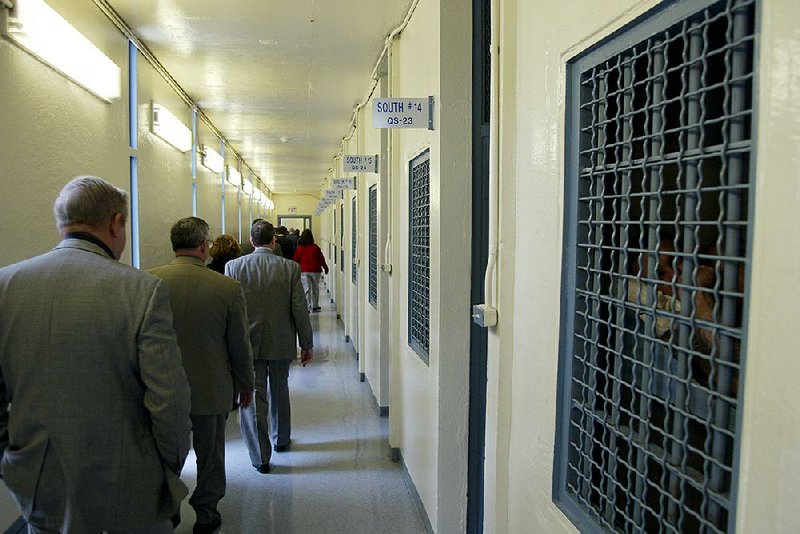The Arkansas Department of Correction, whose officials propose adding up to 400 lockdown cells as part of an effort to quell prison violence, already has more than 2,000 similar cells that are used for reasons ranging from safety threats to medical issues to punishments.
The increase would mean that at least 16 percent of the current prison housing capacity would be restrictive housing.
Last week, the prison department announced that it would seek to convert as many as 400 regular cells into restrictive housing, where inmates can be placed in lockdown for at least 22 hours a day. The plan came in response to a series of violent incidents at several prisons in the state this summer, which prompted Gov. Asa Hutchinson to request more safeguards at the units.
The additional one- and two-man cells could be used to segregate potentially dangerous inmates, or inmates who request such protection or those suspected of breaking rules, such as smuggling in liquor and cigarettes, according to department policy. Department of Correction Director Wendy Kelley told lawmakers Wednesday that the plan was developed in consultation with staff members and would help create a safer workplace for guards. Prisons in the state are struggling with high worker turnover and job vacancies.
"We've come up with ways to make it safer on the inside, and I'm hoping that that will help with recruitment, that staff will feel safer, and they'll feel safer about asking their younger relative to come to work there," Kelley said.
Arkansas' crowded prisons, which house around 16,000 inmates, are equipped with 2,191 restrictive housing beds, according to Solomon Graves, a spokesman for the Department of Correction.
Most of the remaining beds, known as general population beds, consist of bunks in open barracks or are in cells that open into a common area throughout most of the day.
Of the restrictive housing cells now available, 638 are being used for punitive reasons, Graves said. The remainder are used for administrative segregation. Department policy allows their use for an array of reasons, ranging from escape risks and inmates in medical isolation to someone who is deemed to pose a safety threat. Graves said the newly converted cells will likely be used for administrative segregation but could be used for punitive purposes, if needed.
Department policy states that an inmate in administrative segregation cannot be housed in the same cell as an inmate on punitive isolation. While some restrictive housing cells offer inmates normal access to televisions or magazines, inmates in punitive isolation lose such privileges and other amenities.
During the day, department policy requires that mattresses be removed from punitive isolation cells, which all have solid doors. Graves said most punitive isolation cells receive "forced air," meaning they are not directly heated or cooled.
"For an inmate to be housed in punitive isolation, the inmate must be found guilty of a disciplinary violation which poses a direct threat to the safety of persons or a clear threat to the safe and secure operations of the facility," Graves wrote in an email. "While violent behavior would meet that threshold, so would other activities."
Nationally, the use of isolation -- commonly referred to as solitary confinement -- has come under increased scrutiny. (The Arkansas Department of Correction does not use the term solitary confinement.)
In 2014, a study of inmates in the New York City jail system that was published in the American Journal of Public Health found that inmates who had been in solitary confinement were much more likely to harm themselves or attempt suicide.
Federal prisons and correctional systems in other states have announced policies to scale back the use of isolation. Texas abandoned the use of isolation as a form of punishment last month, after it was deemed unnecessary, according to a spokesman for that state's prison system.
"The [Texas Department of Criminal Justice] has made significant strides over the last several years in reducing the number of offenders in administrative segregation and solitary confinement with a priority placed on safety and security," spokesman Jason Clark said in an email. "This was accomplished by diverting offenders from entering restrictive housing and offering pathways out through targeted programming."
Texas still uses administrative segregation to isolate inmates who pose security risks -- such as dangerous gang members -- in one-man cells, Clark said. Offenders kept in administrative segregation accounted for about 2.7 percent of Texas' 145,149 prisoners, he said.
In Arkansas, the Department of Correction also has taken steps to limit the use of restrictive housing. In August, at a Board of Corrections meeting where Kelley stressed the need for more isolation cells, she also announced that the department had adopted a new policy to end the use of isolation as a punishment for lesser offenses like skipping work duty.
The department also limits stays in restrictive housing to 30 days at a time, and longer stays must be broken up by 48-hour-long breaks. Inmates are observed at least every 40 minutes and have access to mental health counselors, according to department policy.
In her address to lawmakers, Kelley said recent legislative attempts to divert mentally ill people into treatment centers outside prison could help free up space in restrictive housing cells.
"We have a lot of restrictive housing cells that are set up just for them, and they get treatment and they get brought out and all of that," Kelley said. "If those people didn't come to prison, those could be resources that we use for other people that the community is afraid of."
Still, former prison employees who spoke to the Arkansas Democrat-Gazette recently described restrictive housing as a pervasive tactic used to deal with inmates.
"We could always use [isolation cells] whenever we wanted to," said Christina Hall, a 24-year-old who was a sergeant when she quit working at the East Arkansas Regional Unit in Lee County this summer. "If an inmate had a disciplinary violation, or if we just wanted to lock them up, we could."
Hall said she stopped working for the Department of Correction after being harassed by a supervisor.
Hall and another former corrections officer, Cassandra Summers, 37, said that at the East Arkansas unit in Brickeys, in addition to being sent to isolation for fighting or sexual assault, inmates were frequently put in restrictive housing after making suicidal threats, or using dangerous synthetic forms of marijuana known as K2.
Both former employees said they needed a supervisor to sign off on paperwork before putting inmates in restricted housing. Summers described the restrictive housing as going to "the hole."
Asked if inmates were being placed in restrictive housing while under the influence of drugs or alcohol, Graves pointed to the department's disciplinary policy, which puts using drugs, alcohol or cigarettes under the class of penalties that's punishable by punitive isolation. Inmates can be placed in restrictive housing while awaiting a disciplinary hearing.
Neither of the guards who spoke to the Arkansas Democrat-Gazette said they believed that the department's plan to add hundreds of isolation cells would improve safety.
More than a half dozen guards and inmates have been hospitalized this summer after violent altercations at several prisons. One inmate has died as a result of violence.
"It's going to make it a lot worse," Hall said. "It's going to anger the inmates who are already in general population."
The chairman of the legislative committee that heard from Kelley, Sen. Joyce Elliott, D-Little Rock, also expressed skepticism about the plan when talking with reporters. She said she wanted to do more research on it.
"I would like to know more about -- are there other best practices of dealing with anyone whose involved in these incidences in prisons?" Elliott told reporters. "I get the impression that a part of the response is just more punishment, and obviously that's not working. Because sooner or later, most of these people are going to be back into society. I would really like to know what are we doing to help correct behavior when obviously just the threat of punishment is not working."
Legislation would not be required to convert the cells, though lawmakers and the governor would have to sign off if the Department of Correction seeks surplus funds for the project.
The plan to convert cells into restrictive housing is still being finalized, Graves said, and cost estimates were not yet available.
A Section on 10/16/2017



